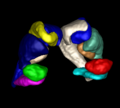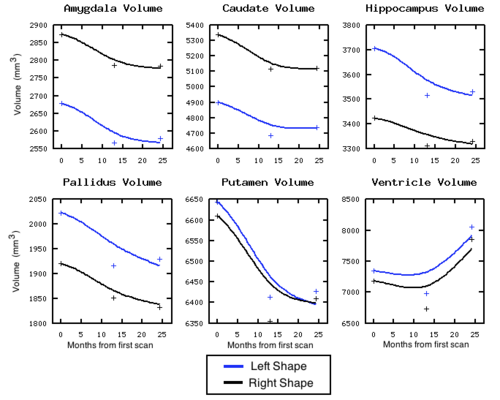Difference between revisions of "2011 Summer Project Week long shape regression"
Jfishbaugh (talk | contribs) |
Jfishbaugh (talk | contribs) |
||
| Line 20: | Line 20: | ||
We would like to estimate continuous growth scenarios for several shapes of interest, which can eventually be combined with a framework for 4D registration or 4D atlas construction, to statistically analyze the growth variability within a population. We do not have point correspondences between our shapes, so we use a Gaussian mixture model based tool called gmmreg to rigidly align the shapes. | We would like to estimate continuous growth scenarios for several shapes of interest, which can eventually be combined with a framework for 4D registration or 4D atlas construction, to statistically analyze the growth variability within a population. We do not have point correspondences between our shapes, so we use a Gaussian mixture model based tool called gmmreg to rigidly align the shapes. | ||
| − | |||
| − | |||
</div> | </div> | ||
| Line 44: | Line 42: | ||
'''Preprocessing''' | '''Preprocessing''' | ||
| − | In order to prepare the shapes for longitudinal regression, the different time points must first be rigidly aligned. | + | In order to prepare the shapes for longitudinal regression, the different time points must first be rigidly aligned. We initially align all the shapes jointly, rather than individually, in order to preserve the spatial relationship between the anatomical structures. However, there was a small amount of translation and rotation remaining after this process that adversely impacts the growth estimation. To further align the shapes, we also register each shape individually across time. |
</div> | </div> | ||
Revision as of 13:35, 24 June 2011
Home < 2011 Summer Project Week long shape regressionLongitudinal Shape Regression - Huntington's Disease
Key Investigators
- Utah: James Fishbaugh, Marcel Prastawa, Guido Gerig
- Iowa: Hans Johnson
Objective
To begin processing longitudinal Huntington's disease data and to apply our shape regression framework to available data. We are interested in the evolution of sub-cortical structures in the brain.
We would like to estimate continuous growth scenarios for several shapes of interest, which can eventually be combined with a framework for 4D registration or 4D atlas construction, to statistically analyze the growth variability within a population. We do not have point correspondences between our shapes, so we use a Gaussian mixture model based tool called gmmreg to rigidly align the shapes.
Approach, Plan
- Segment sub-cortical structures
- Estimate growth trajectories
Progress
Segmentation
The 6 pairs of sub-cortical structures (amygdala, caudate, hippocampus, globus pallidus, putamen, lateral ventricle) were segmented using a deformable atlas based pipeline used at the University of Utah. The quality of the ventricles was very poor, so they were further improved by an active contour based segmentation tool, itkSNAP. After this stage, we have 12 shapes at 3 time points.
Preprocessing
In order to prepare the shapes for longitudinal regression, the different time points must first be rigidly aligned. We initially align all the shapes jointly, rather than individually, in order to preserve the spatial relationship between the anatomical structures. However, there was a small amount of translation and rotation remaining after this process that adversely impacts the growth estimation. To further align the shapes, we also register each shape individually across time.

References
Fishbaugh, J., Durrleman, S., Gerig, G. "Estimation of Smooth Growth Trajectories With Controlled Acceleration From Time Series Shape Data". MICCAI 2011. To appear.


